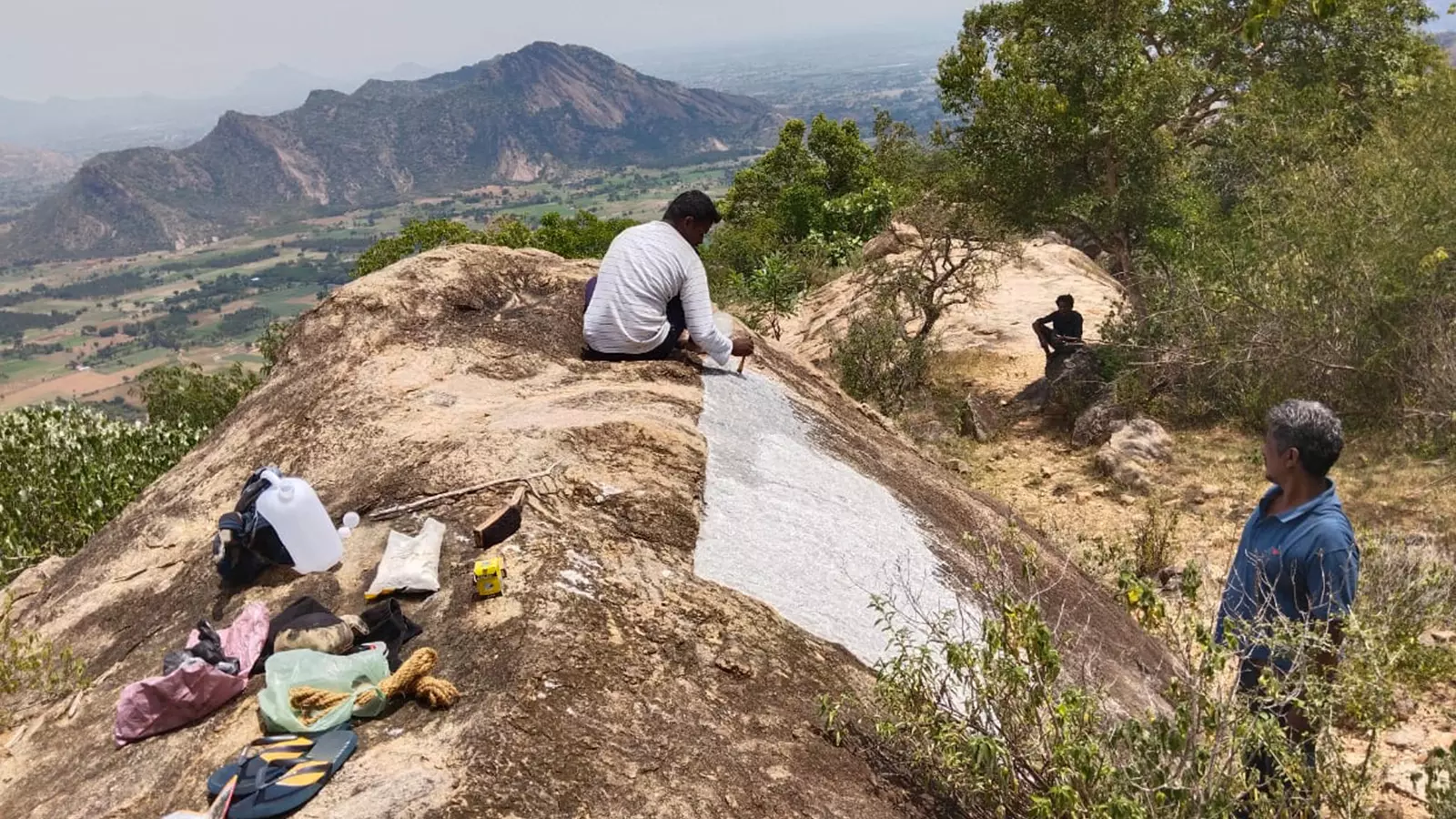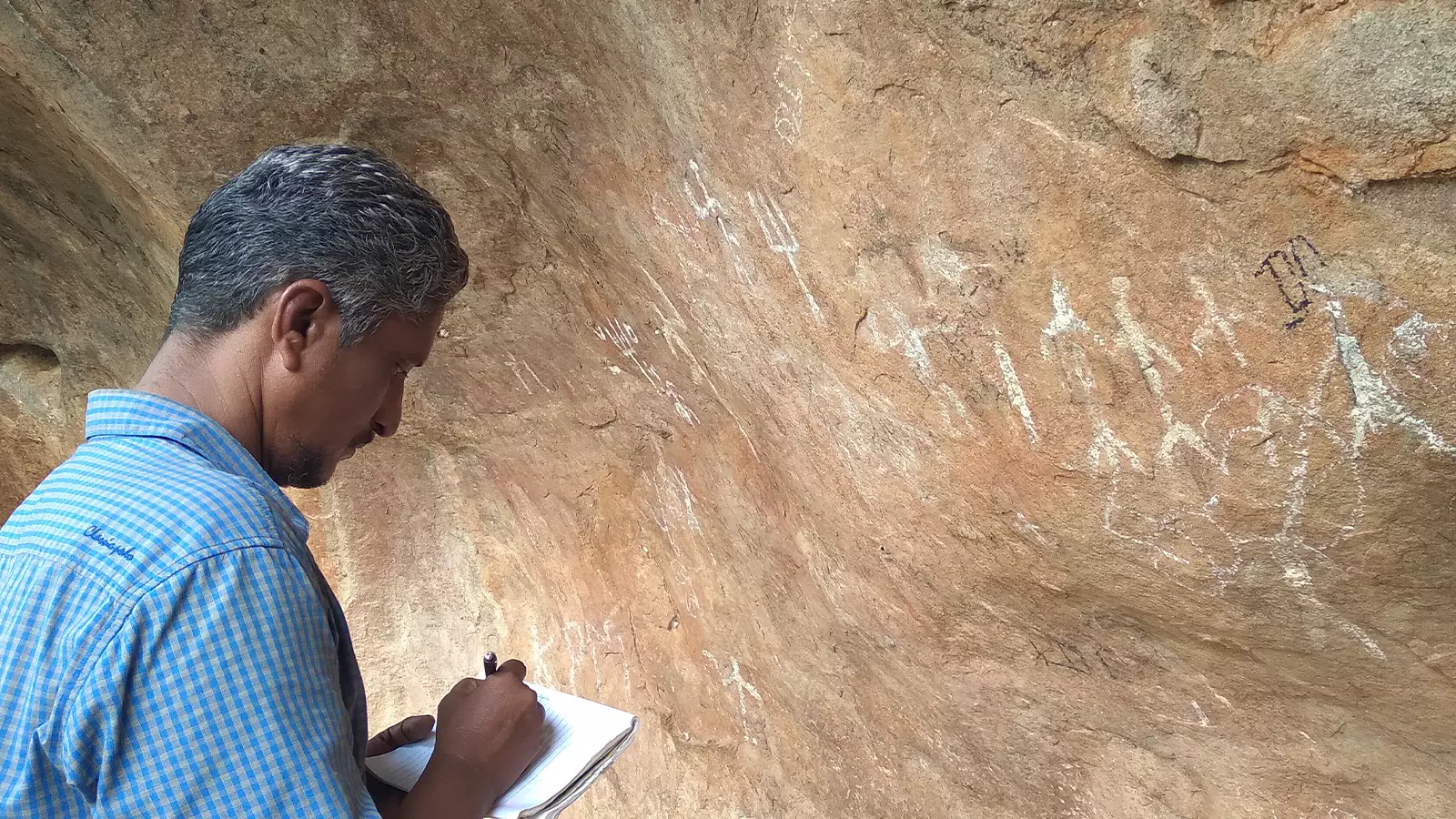
- Home
- News
- Analysis
- States
- Perspective
- Videos
- Education
- Entertainment
- Elections
- World Cup 2023
- Features
- Health
- Business
- Series
- Economy Series
- Earth Day
- Kashmir’s Frozen Turbulence
- India@75
- The legend of Ramjanmabhoomi
- Liberalisation@30
- How to tame a dragon
- Celebrating biodiversity
- Farm Matters
- 50 days of solitude
- Bringing Migrants Home
- Budget 2020
- Jharkhand Votes
- The Federal Investigates
- The Federal Impact
- Vanishing Sand
- Gandhi @ 150
- Andhra Today
- Field report
- Operation Gulmarg
- Pandemic @1 Mn in India
- The Federal Year-End
- The Zero Year
- Premium
- Science
- Brand studio
Battling bees, traversing dense forests, a man’s quest for prehistoric rock art sites in Tamil Nadu

KT Gandhirajan’s journey in search of prehistoric rock art sites in Tamil Nadu began 25 years ago. As of today, he has discovered more than 25 rock art sites across Tamil Nadu. And that too without getting any support from institutions and colleges.It’s his unending love for ancient history and art that makes this artist-historian trek to forests and hills in search of prehistoric rock...
KT Gandhirajan’s journey in search of prehistoric rock art sites in Tamil Nadu began 25 years ago. As of today, he has discovered more than 25 rock art sites across Tamil Nadu. And that too without getting any support from institutions and colleges.
It’s his unending love for ancient history and art that makes this artist-historian trek to forests and hills in search of prehistoric rock art sites. As a child, Gandhirajan was taken to the temples atop the hills in and around Usilampatti, his native place, by his parents and relatives.
Regular visits to the hills eventually helped him establish a sense of attachment with them. He would stand atop the hills and watch the trees. Surrounded by mountains, the remoteness of Usilampatti influenced Gandhirajan a lot. He was interested in arts, but he didn’t find any artist in his village. He would go to Madurai and look at the sculptures in the temples there, particularly in the Meenakshi temple there. When he grew up, his parents asked him to study chemistry, which he did but he soon found a place which he liked: the Government College of Fine Arts in Chennai.

KT Gandhirajan's regular visits to the hills eventually helped him establish a sense of attachment with them.
But he found students there more focused on a particular genre of painting. He discontinued his course, and joined Madurai Kamaraj University in 1992 to study art history and aesthetics as part of his post-graduation. After post-graduation, he returned to Chennai, and joined his alma mater as a guest lecturer. It was here that he started travelling to forests and hills with his colleagues. Caught between wild animals and bees, he had to spend days inside the forest without food. He was stung by wild bees once while documenting a rock art site that he discovered near Coimbatore.
Rock art, according to Gandhirajan, refers to a form of artistic expression that involves creating designs on natural rock surfaces, often in outdoor settings, preferably a cave or rock-dwelling. He said this art form has been practised by various cultures throughout human history and can provide valuable insights into the beliefs, rituals and daily life of ancient societies. There are two types of rock arts. They are pictographs and petroglyphs. Pictographs are rock art images created by applying pigments, such as minerals, plant materials or animal blood, directly to the rock surface. One can see intricate designs, symbols and scenes painted in various colours in pictographs. However, petroglyphs are images or designs that are carved or engraved into the rock surface. They are created by removing layers of rock to reveal the underlying surface and they can range from simple symbols to intricate depictions of animals, humans and other subjects.

Gandhirajan at a rock art site in Tamil Nadu.
There are more than 5,000 rock art sites in India and Tamil Nadu has so far discovered 150 sites. It was KV Raman who discovered the first rock art in which a man rode a horse in Mallapadi in the Dharmapuri district of Tamil Nadu in 1978. Rock arts were not considered a source of historical and cultural information of prehistoric society in the 1970s and 1980s. It was during this time, Gandhirajan documented the mural paintings in more than 50 temples and palaces in Tamil Nadu as part of his PhD at University of Madras.
“My first association with mural paintings in temples and palaces eventually led me to rock arts. Even though I was fascinated by these prehistoric art works, I seriously thought about it after I documented the mural paintings in these temples,” said Gandhirajan, who is an historian and resource person at Tamil Virtual Academy, Chennai.
Gandhirajan has discovered more than 25 rock arts sites in Tamil Nadu so far. Besides, he has discovered many hero-stones, dolmens and archaeological sites. Gandhirajan’s first discovery of a rock art painting site was in Theni, done with his friend and archaeologist V Selvakumar. “Rock art is not studied in detail the way they are done in countries like Australia. When I started my research, I found that there is no good guide to prehistoric rock arts in India. Regular surveys and treks through the dense forests helped me discover seven rock art sites in The Nilgiris itself,” said Gandhirajan who is working on a book based on his latest rock art explorations in Tamil Nadu.
Trekking to the dense forest in search of rock art sites is challenging. “Each exploration is an inquiry, relating to the ancient human being and their art forms. I sit inside the cave dwelling for hours, to get the feel of the artists that they had undergone while doing these paintings. Why did they do it? I do sketches imitating those ancient works sitting inside the cave itself. And that’s how I interact with the ancient artists,” said Gandhirajan, who has travelled to more than 200 rock arts sites in India.
Barring the rock arts in Bhimbetka, no serious studies have been conducted in the field. Situated in the foothills of the Vindhya range in Central India, the Bhimbetka site, 45 km from Madhya Pradesh’s Bhopal, comprises 243 shelters of which 133 are rock paintings. It was granted UNESCO World Heritage Status in 2003. With works from the palaeolithic and mesolithic periods, and historic period, the Bhimbetka opens a window to ancient human life. The earliest painting in the shelter is said to be 10,000 years old.

“You can’t make a difference between a man and a woman in the early rock arts. The vibrant and creative elements that the ancient artists used need to be studied in detail. It is the best way to understand the cultural and social history of ancient people and their society. In India, Bhimbetka is the only rock art site that got the prominence that it deserves. Many rock arts sites in India, particularly those in Tamil Nadu, are becoming soft targets for vandals due to lack of care and maintenance,” he added.
In the Nilgiris, Gandhirajan was once stung by a colony of wild bees while taking photographs of a rock art site that he had explored. “I think it was in 2005. I had only a small camera, and taking photographs was difficult those days unlike today. I wanted to take better angles, and during this time, I accidentally disturbed a beehive nearby. A colony of wild bees started attacking me. I was not able to come out of the cave. With the help of friends, I somehow managed to escape but by the time I had lost my consciousness. I was stung by more than five bees. There are many such incidents that we face, but life is a journey, in search of rock arts. So I don’t look back,” said Gandhirajan.

